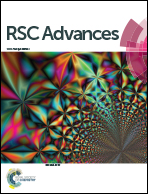Structural, optical and magnetic properties of Sm doped ZnO at dilute concentrations
Abstract
The present study focuses on the structural, optical and magnetic properties of Sm doped ZnO at very dilute concentrations (<3%). These compounds have been synthesized by a solid state reaction method after prolonged mixing by ball milling and characterized by X-ray diffraction (XRD), scanning electron microscopy (SEM), optical spectroscopies (such as UV-Vis, photoluminescence (PL) and Raman) and magnetization methods (M–H). The XRD results show a small change in lattice parameters due to Sm doping in hexagonal wurtzite ZnO and the absorption edge shows a small red shift for ZnO:Sm which indicates the substitution of Sm ions for Zn sites. PL and micro-Raman studies confirm the enhancement of oxygen vacancies and surface defects leading to strain in ZnO:Sm which correlates with a peak shift in XRD. PL results show that Sm ions take part in the luminescence process by capturing some excited charges in the non-radiative process. The green band is attributed to the radiative recombination of photogenerated holes with electrons occupying the singly ionized oxygen vacancy. The spectral chromicity color coordinates indicate white light emission under UV excitation, making them promising candidates for use in white LEDs. Magnetic measurements show an enhancement in room temperature ferromagnetism (FM) with Sm doping. The absence of any metallic segregation or impurity phase, along with the field dependence of magnetization M–H, exhibits the intrinsic nature of FM. The oxygen vacancies mediate the interaction of dopant ions, and the origin of FM can be elucidated by the bound magnetic polaron (BMP) mechanism.


 Please wait while we load your content...
Please wait while we load your content...